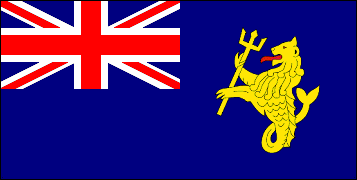OTHER ORGANIZATIONS |
|

THE COLLEGE OF ARMS •
ARMORIAL BANNER |

THE CINQUE PORTS •
ARMORIAL BANNER |
|
The College of
Arms is part of the Royal Household, responsible for the granting
and registration of coats of arms and all related heraldic
activities for England, Wales and Northern Ireland. (Scotland has a
separate heraldic authority.) Its flag is an armorial banner or
banner of arms, i.e. the shield of its coat of arms rendered in flag
form. The Confederation of Cinque Ports (from Norman French, meaning
five ports after the five towns originally designated) is
made up of 42 coastal towns in Kent and Sussex at the eastern end of
the English Channel. Established by Royal Charter in 1155, the
Confederation’s principal purpose was to provide what today would be
called a naval reserve: some 50 ships with crews available to the
Crown in case of need. In return the Cinque Ports received a number
of privileges including exemptions from taxes and duties. From the
fourteenth century onward the Cinque Ports declined in importance
and today the designation is purely honorary and ceremonial. The
Crown appoints the Lord Warden of the Cinque Ports, an honor usually
bestowed on a member of the Royal Family or a prominent subject. The
flag of the Cinque Ports, a banner of their arms, is thought to be
one of the most ancient in England.
|

TRINITY HOUSE ENSIGN |
|

NORTHERN LIGHTS ENSIGN |

COMMISSIONER OF NORTHERN LIGHTS
FLAG |
|
Trinity House
is a private corporation operating under a Royal Charter. Founded in
1514 and headquartered in London, It is the official General
Lighthouse Authority for England, Wales, the Channel Islands and
Gibraltar, responsible for the operation and maintenance of
navigational aids, such as lighthouses, lightvessels, buoys, and
maritime radio/satellite communication systems. The Corporation is
also an official deep-sea pilotage authority, providing expert
navigators for merchant vessels in northern European waters.
Additionally it carries out a number of charitable activities.
Trinity House vessels wear a Red Ensign defaced with its coat of
arms, which in flag form serves as a jack. Vessels belonging to the
Northern Lights organization of Trinity House wear a defaced Blue
Ensign. The flag of the Commissioner of Northern Lights is of
interest because it is the only official British flag or ensign that
still incorporates the pre-1801 version of the UJ, omitting the
Cross of St. Patrick.
|
|

ROYAL NATIONAL LIFEBOAT
INSTITUTION ENSIGN |

MARITIME VOLUNTEER SERVICE ENSIGN |
|
The Royal National Lifeboat
Institution is a charitable organization operating over 250 lifeboat
stations in the British Isles, including Ireland. Founded in 1824,
it was granted a Royal Charter in 1860. The defaced Red Ensign for
the use of its watercraft displays the RNLI house flag, which is
used on land. The Maritime Volunteer Service was founded in 1994 as
a charitable organization to support port and river authorities
around the UK. The MVS also operates as a youth organization,
offering maritime experience and training to young people. In 1997
the MVI received formal recognition from the Royal Navy and the
following year an Admiralty Warrant was issued authorizing the MVI
to use a Red Ensign defaced with its badge. |
|

PORT OF LONDON AUTHORITY
ENSIGN
|

COMPANY OF WATERMEN AND
LIGHTERMEN
OF THE RIVER
THAMES |
|
The Port of
London Authority, responsible for the management and regulation
of matters relating to the city's port facilities, has a defaced
Blue Ensign for use by its vessels. The origins of the Company
of Waterman and Lightermen of the River Thames go back to 1514,
when the river was London's principal highway with watermen
transporting passengers in their boats and lightermen
transporting cargo. Today the Company combines the functions of
a trade union, a fraternal order and a charity. Its Red Ensign
is defaced with the arms granted in 1585.
|
|

ROYAL YACHT SQUADRON
• ENSIGN & BURGEE |
|

ROYAL ALBERT YACHT CLUB
• ENSIGN & BURGEE |
|

HOUSE OF COMMONS YACHT CLUB
• ENSIGN & BURGEE |
|
Most British yacht
clubs have a distinctive triangular pennant, called a burgee, and
in addition many have received an Admiralty Warrant to
fly a distinctive ensign. Clubs with a burgee only use the undefaced Red Ensign or, with permission, the undefaced Blue
Ensign; distinctive ensigns can be either blue or red, with the
club's badge in the fly. The Royal Yacht Squadron has the unique
privilege of using the White Ensign, which otherwise is reserved
for the Royal Navy. Maritime custom dictates that the ensign
should be displayed at the stern and the burgee at the main
masthead.
|